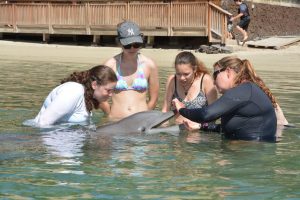This morning we visited Dolphin Quest Hawaii, located at the Hilton Waikoloa Village North of Kona. We had been looking forward to meeting their animal care professionals about the research and conservation initiatives undertaken there. Dolphin Quest was founded in 1988 by two marine mammal veterinarians, with the goal of connecting people to nature and our oceans through intimate, personal interactions with marine life. There are currently 13 Atlantic bottlenose dolphins (Tursiops truncatus) at Dolphin Quest, most of whom were born there, and they range from 3.5 to 45 years old.
We began the day by learning about the research initiatives and educational programs Dolphin Quest engages in. We’ve seen on both Oahu and Hawaii how much of a priority education is to local leaders, and it was encouraging to hear that they offer grants to bring school children from across the the island to do marine science field trips that otherwise would be unable to visit. Each year they have thousands of students come to Dolphin Quest, from kindergarten to college undergraduates, and today we helped them add graduate students to their list of visitors for the year!

Next we ventured onto the docks to see demos of different sample collections. We saw an eight year old male named Hua, born on easter and thus named “egg” in Hawaiian, calmly present his flukes for a blood draw. These husbandry behaviors not only allow veterinarians to keep tabs on the health of the dolphins here, but allow researchers to study how contaminants in a mother travel through her milk to her calf. Dolphin Quest pioneered the ability to calmly take monthly morphometrics and blood samples from newborn dolphin calfs, starting as young as 1 month old. Researchers have found some wild populations to have blood mercury levels to be 10x higher than dolphins at Dolphin Quest, indicating a further need to study contamination pathways in wild populations.

We also saw the training that goes into milk and “chuff” (snot) sample collection, which are just a few of the many samples the dolphins voluntarily provide. Measuring baselines and controlling for variables in populations in human care allow for increased understanding of threats facing wild populations.

We ended the morning by talking about conservation topics Dolphin Quest shares with guests. They encourage guests to use reuse water bottles, conserve water, and reduce, reuse, and recycle. However, even more effective are the personal resolutions that trainers and educators make and subsequently share with their guests (eg. forgoing straws, using bamboo toothbrushes, and placing a gallon of water in the toilet reservoir to reduce water consumption) They challenge guests to come up with their own resolutions. “Walking the talk” goes a long way and seems to be a part of Dolphin Quest culture. At our program in Duke’s Nicholas School of the Environment we’ve seen that in order to inspire behavioral change in others, you have to wholeheartedly believe in your message and be true to it in your everyday life. Today was a touching reminder of how passionate people, together with amazing up-close interactions, can leave you profoundly inspired and ready to take on the next challenge facing our environment.
